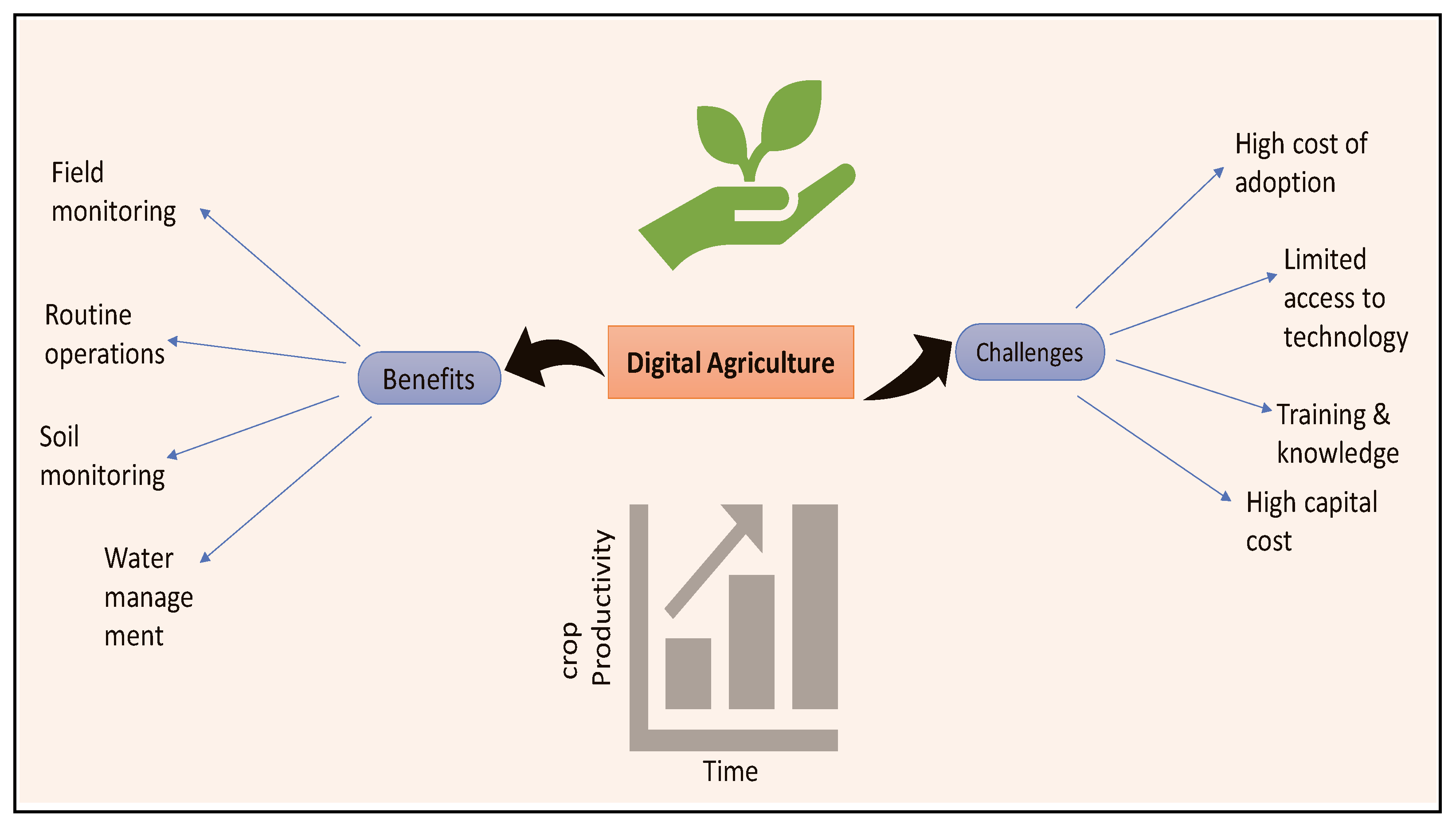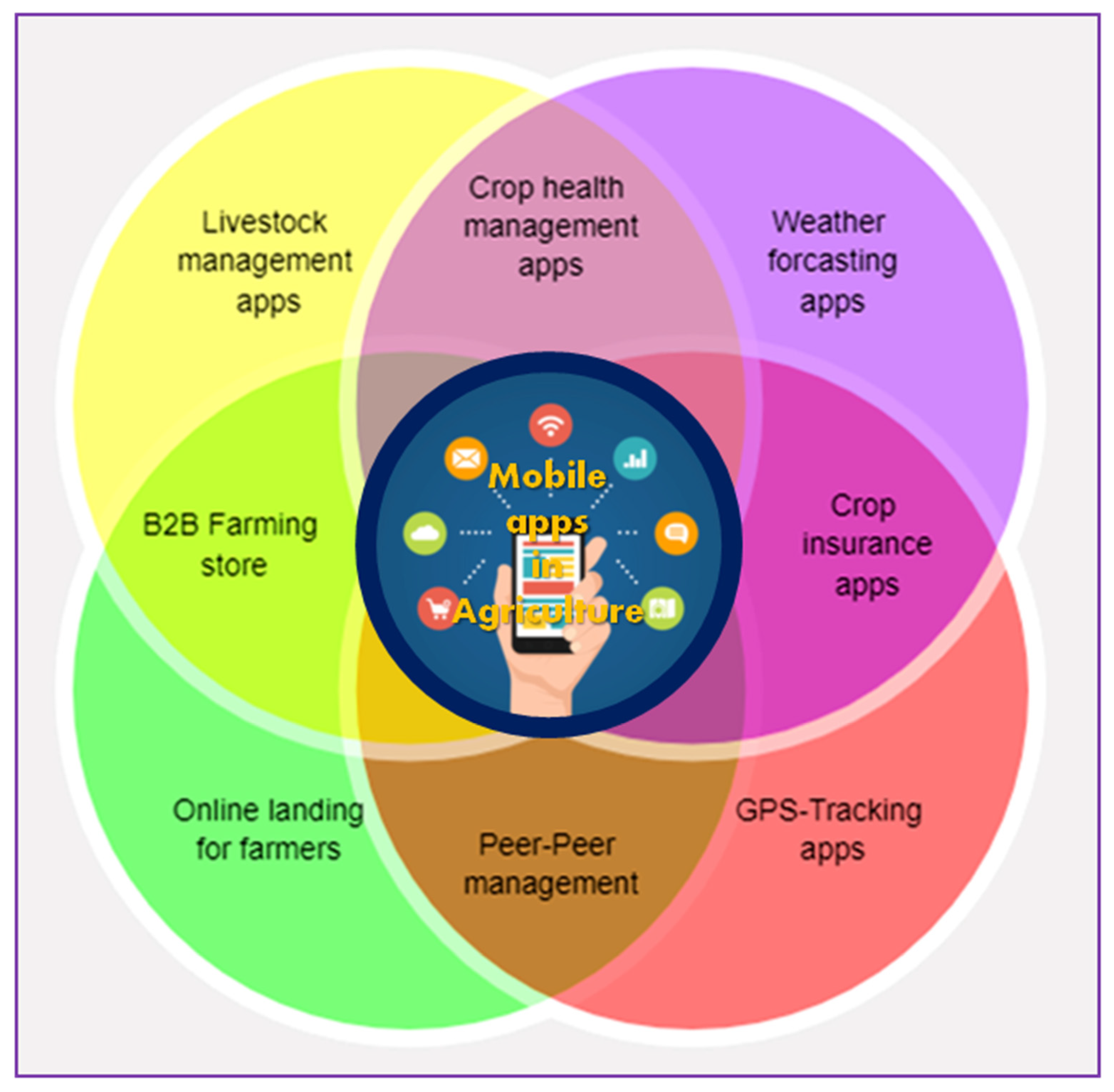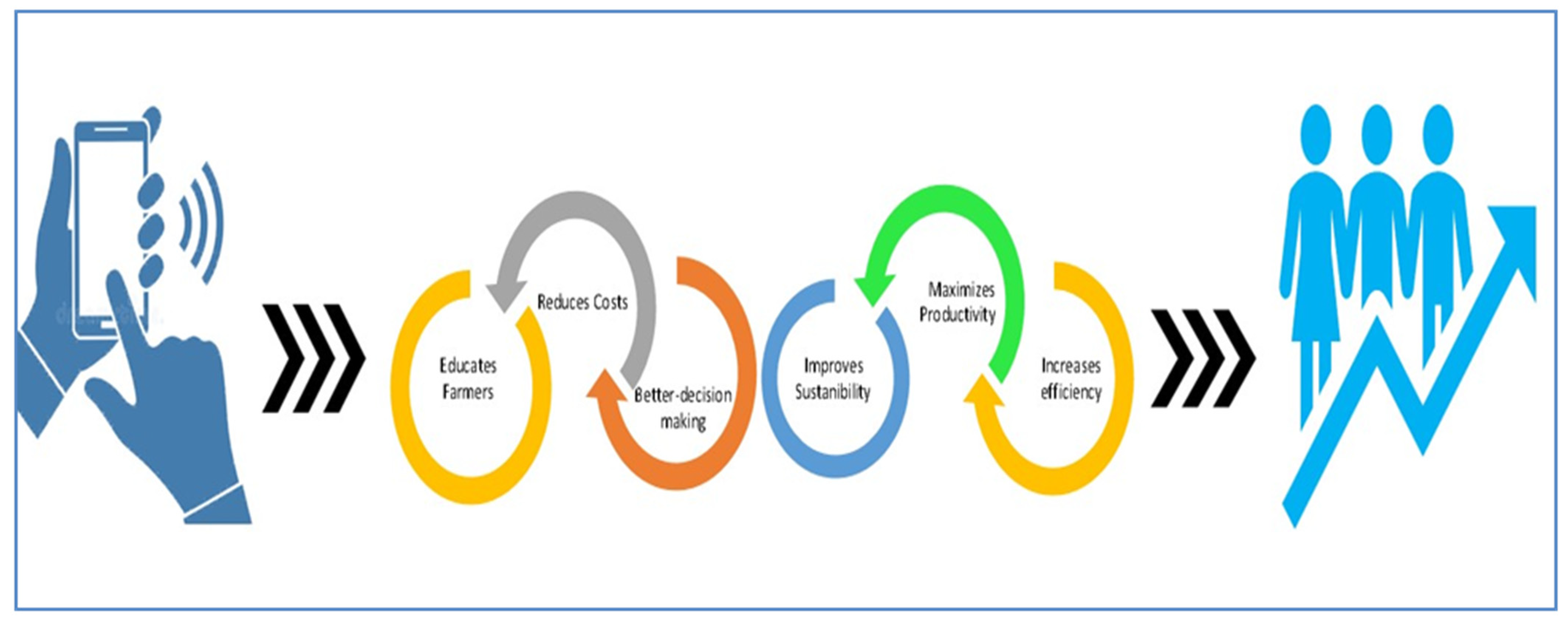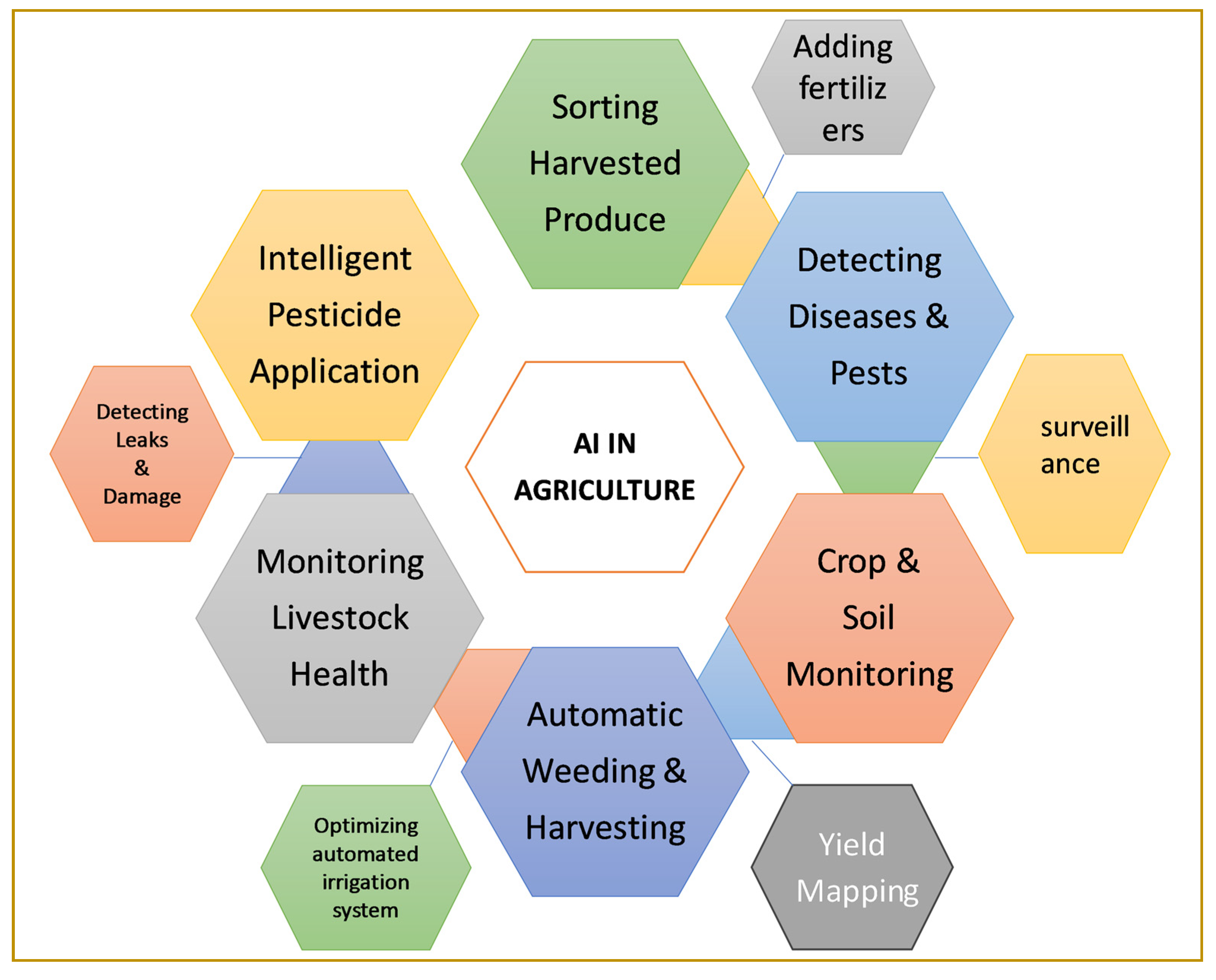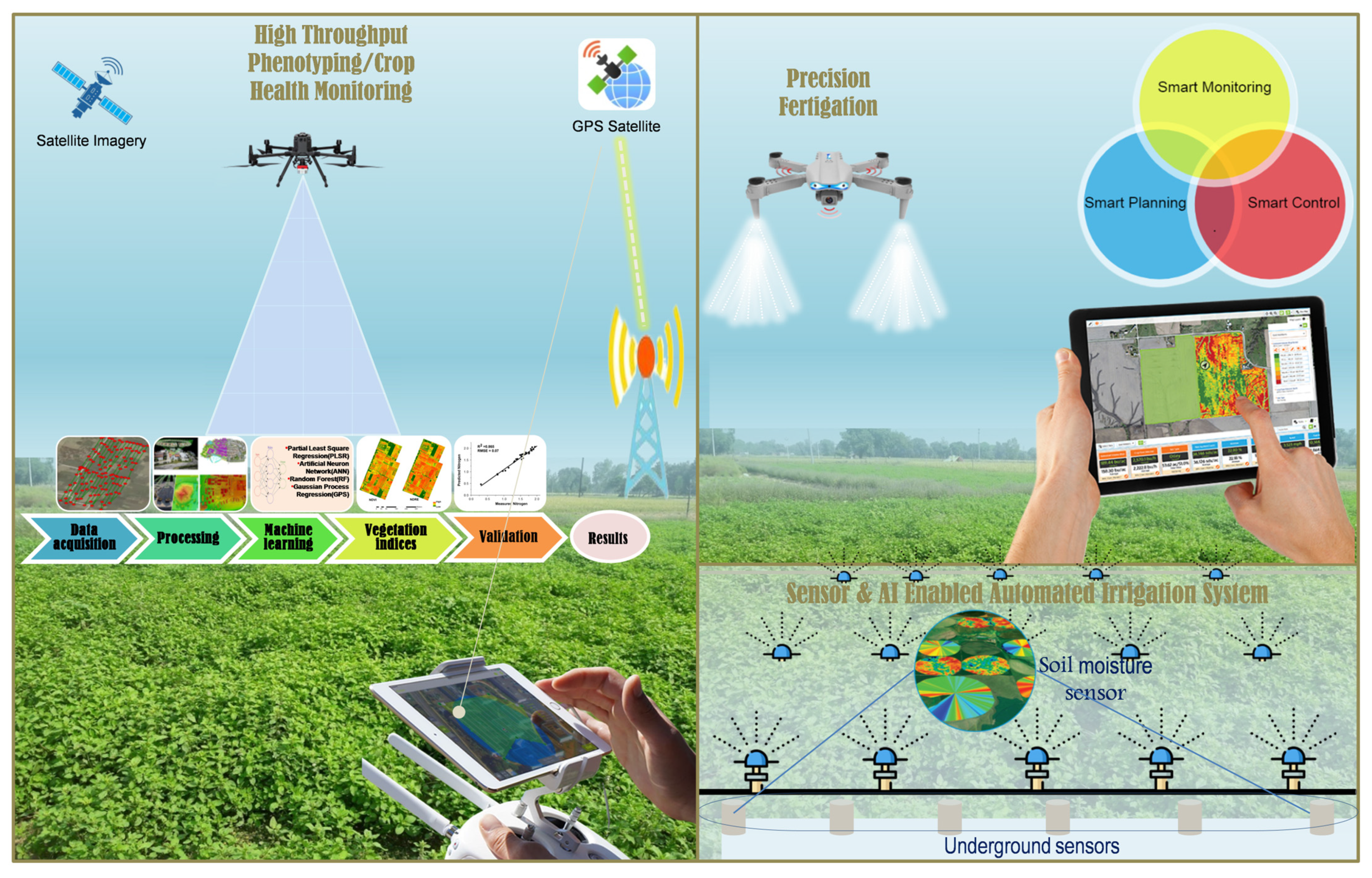Agriculture is essential to the existence of the human race, as well as the foundation of our civilization, because it provides food, fuel, fiber, and other resources necessary for survival; however, it is facing critical challenges due to anthropogenic climate change, which hampers food and nutritional security. Several measures have been implemented to enhance agricultural productivity, including plant breeding, genetic engineering, and precision agriculture. The world has witnessed the burgeoning development of novel scientific innovations and technological advancements enabled by drones, smart sensors, robotics, and remote sensing, resulting in a plethora of revolutionary methods that can be applied to real-time crop modeling, high-throughput phenotyping, weather forecasting, yield prediction, fertilizer application, disease detection, market trading, farming practices, and other environmental practices vital to crop growth, yield, and quality. Digitalization is the most significant technological advancement of our time, and it profoundly affects agriculture and other industries. Delivering a comprehensive view of how technology could help in tackling critical issues like environmental degradation and threatened world biodiversity, this perspective emphasizes the perks of digitalization.
1. Digital Technologies and Their Contribution in Agriculture
Over the past few decades, agriculture and food production have rapidly changed due to the increasing prevalence and mobility of digital technology
[1]. The proliferation of mobile technology, remote sensing services, and distributed computing in food and agriculture is already enhancing smallholders’ access to markets, information, and inputs. It also boosts productivity and production, optimizes supply chains, and cuts operational costs. However, there are obstacles to overcome in the “digitalization” of agriculture and the food value chain. These include high initial implementation costs, especially for small farmers, limited digital literacy among farmers, reliable access to high speed internet in rural areas, and data security concerns. To guarantee that everyone gains from the developing digital society, the FAO is dedicated to supporting partners and governments in bridging such transdisciplinary digital gaps
[2] (
Figure 1).
Figure 1. A schematic representation of the benefits and challenges of digitization in agriculture.
Using digital technology to link agricultural production from the paddock to the customer is known as “digital agriculture”. Digital technologies can help emerging nations more quickly combat hunger and global poverty in rural areas
[3]. Prominent technical developments include precision agriculture, artificial intelligence, blockchain, automation, robotics, livestock technology, indoor vertical farming, and contemporary greenhouse techniques. Farm equipment is linked to software systems that collect data from the farm and allows for studies of the soil and climate in particular areas. This will enable farmers to receive recommendations on seed selection and more accurate application of fertilizer and pesticides. Mobile phones have one of the greatest adoption rates among all the technologies invented in the last century. Digitalization will bring farmers and customers closer
[4]. Customers can see more transparency in farming thanks to the accessible information on plants and animals. Agricultural productivity will be impacted by smart farming in the long run
[5].
2. Mobile Applications and Farm Management Software (FMS)
Global connectedness has increased since the introduction of digital technologies. There is a smaller, faster, cheaper, and more efficient way to use mobile devices. Many farmers and businesses are receiving assistance so they may make better decisions. Assistance is being provided to farmers so they may operate more efficiently and apply fertilizer and water in more precise amounts. Digital technologies facilitate a multitude of operations, such as planning farming activities, budgeting, reporting, and keeping track of chores and performance. Agronomy, farm equipment, livestock handling facilities, communication, and other fields all make use of digital technologies. A new agricultural revolution will begin, and connectivity and data will be crucial. Advanced technologies such as artificial intelligence, analytics, and linked sensors can improve yields and boost the efficiency of water and other inputs. These can support the development of resilience and sustainability in both crop and animal husbandry. Robotics, automation, and sensor applications are examples of digital agricultural technologies used in production systems
[6][7]. These days, farmers have access to a variety of applications. While most are accessible in Hindi and English, several offer additional regional languages to improve communication with farmers and cover all parts of the nation
[8] (
Figure 2).
Figure 2. Implications and importance of mobile application in agriculture.
The main focus of crop advising apps is how to manage the crop beforehand for a higher yield at a reduced cost. This makes the information easy and clear for farmers to understand
[9]. Applications for soil testing are also accessible to farmers to test the soil and determine which crops will do well in a specific soil type
[10]. Specific applications also provide market prices and the most recent information on the farming techniques used by farmers across the nation
[11]. It will be possible for farmers to ascertain which crops yield a profit in a given season. Various mobile apps in Indian agriculture, like FarmersEdge, AgriApp, and AgriBus-NAVI, offer farmers tools for data-driven decisions, weather updates, crop disease diagnosis, and navigation support. Apps such as Plantix assist with crop diseases and nutritional deficits. FarmLogs provides comprehensive farm management tools, including crop health monitoring and financial insights. Krish-e offers a customized crop calendar and agricultural consulting, while Kheti Badi focuses on organic farming information in multiple languages. The Crop Insurance app helps farmers calculate insurance rates, and Krishify serves as a social farming app. Pusa Krishi, Shetkari, and Kisan Suvidha introduce technologies, market prices, and government initiatives, enhancing farming productivity. MenthaMitra, developed by CSIR-CIMAP, provides precise information for menthol mint growers, fostering collaboration among stakeholders and scientists
[12][13].
Mobile apps have completely changed how stakeholders worldwide participate and disseminate information thanks to their enhanced user-friendliness, dependability, and connectivity
[13]. By ensuring that farming communities implement the good agricultural practices that researchers have devised and by making them aware of these practices—which can be readily accomplished through a mobile application—the socio-economic situations of these communities can be improved (
Figure 3).
Figure 3. A schematic illustration of socio-economic transformation through mobile applications.
AI and IoT coordination is a part of the integrated strategy that is farm management software. It provides an improved tracking mechanism for analyzing many types of biological, chemical, and physical production
[14]. With real-time data processing capabilities, it requires fewer workers. Thus, with less work and time, FMSs can support the sustainability and quality of agricultural produce. Modern farmers do not use traditional farming methods; to assist them in managing their farms, the majority of farm management software is available as open source
[15]. An application or collection of programs known as farm management software aids in automating, enhancing, and supporting farm businesses’ operational procedures. These management tools help with error correction, task completion, reporting, and general efficiency and effectiveness enhancement. All things considered, farm management software is made to best satisfy the requirements of company procedures. Deciding on an effective FMS is not usually simple because different FMS characteristics are employed for various objectives
[16].
3. Crop Monitoring and Phenotyping Using Artificial Intelligence
AI in agriculture refers to using AI to enhance agricultural productivity and real-time monitoring, harvesting, processing, and selling. It is fundamentally playing a significant role in changing the agriculture industry. AI protects the agriculture industry from various threats, including population increases, climate change, job shortages, and food safety. AI has elevated the agricultural system of today to a new level. Crop productivity and real-time monitoring, harvesting, processing, and selling have increased thanks to artificial intelligence. Numerous advanced computer-based technologies are intended to identify multiple crucial criteria, including crop quality, yield detection, weed identification, and many more. AI can actually help the farmers move towards demand-driven agriculture. The world is now rapidly changing its attitude towards acceptance of AI. For instance, recently, the US government introduced a bill called the Farm Tech Act 2023, for regulations in AI technology in the agriculture sector.
In recent years, there have been significant advancements in understanding plant phenomics, making precision farming more possible. This process is due to new technologies that allow detailed study of complex plant features. Deep learning, machine learning, and computer vision, which are measure features of AI, have become increasingly popular in various scientific areas. These AI features are now integrated into non-invasive imaging methods, improving the efficiency of data collection and analysis. This integration helps in creating tools and software for gathering information about plant phenomics in the field. Some open-source systems and tools allow researchers to work collaboratively and share data, providing the large amounts of information needed for reliable plant phenomics analyses. Moreover, they utilize three critical aspects of managing phenomic data: developing models to comprehend the relationships between genotype and phenotype and the interactions in the environment, managing databases to exchange information and resources, and developing algorithms and programs to transform sensory data into phenotypic information.
Repeated experiments under various conditions must be conducted to screen plants for desired traits, considering the statistical requirement for an unbiased evaluation. Phenotyping, a method of assessing plant development in controlled environments, has been extensively debated, but it often fails to accurately represent the development of plants in open-field situations
[17][18]. There is an apparent disparity in plant performance between the lab and the field. Compared to other imaging techniques, AI integration in tomography and thermography is advancing towards smarter, faster, and lower-cost solutions, particularly in phenotyping image data analysis. Sustainable crop production depends on field phenotyping, yet the throughput in the field lags behind indoor facilities, requiring more development to investigate useful applications of phenomics.
According to recent investigations, AI-assisted crop phenotyping and yield predictions have improved crop phenotyping
[19][20][21][22][23][24][25]. Furthermore, the following applications of AI-assisted high-throughput phenotyping platforms have been proven as successful: identifying the plant growth stage in wheat and maize
[20] and segmenting plant images
[21]; semantic segmentation of crops and weeds for oilseed crops
[22]; phenotyping crop disease resistance
[23]; and boosting the productivity of crops
[24][25] (
Figure 4).
Figure 4. Artificial intelligence is transforming the modern agricultural system.
4. Precision Agriculture and Remote Sensing Technologies in Crop Production and Breeding
Precision farming is the most important and sustainable approach to maximizing crop production and improving farmers’ socio-economic and livelihood conditions. A collection of methods known as precision agriculture (PA) can be used in various agricultural research fields, and variable rate technology, site-specific crop management, and prescription farming are among its additional names. It is a novel management method that uses georeferenced data to govern agricultural systems, applies monitoring procedures, and integrates soil, plant, and climate factors to detail georeferenced data employing computers, satellites, positioning systems, and remote sensing equipment to offer information on the better decisions that can be made. Furthermore, after carefully examining all the variables that influence crop growth in a given farm field, it promotes tillage and the accurate application of agricultural inputs, such as herbicides, fertilizers, and irrigation. To put it more clearly, Gomiero
[26] describes it as an information-technology-based agricultural management system used to detect, assess, and control soil variability in terms of space and time within fields to increase profitability, preserve the environment, and promote sustainability. The science of PA uses advanced technology, sensors, and analysis tools to help with management, decision making, and crop production improvements. The world has embraced PA, a novel idea that promises to boost output, cut down on labor costs, and guarantee efficient management of irrigation and fertilizer systems. It uses a lot of data and information to enhance crop quality, yields, and the utilization of agricultural resources
[27]. Farmers have adopted this novel and sophisticated technique in recent years to improve productivity, quality, and yield to deliver optimum inputs like water and fertilizer
[28]. It needs an enormous amount of high spatial resolution data regarding the health or status of the crop during the growth season (
Figure 5).
Figure 5. Precision farming systems combined with drones, sensors, and artificial intelligence.
Drones or UAVs rely mostly on sensor and microcontroller developments designed to make up for pilot absences, allowing autonomous behavior and crewless vehicle flight
[29]. Farmers have been employing these drones to spray chemicals for years since they are believed to be highly practical and efficient in overcast conditions. The problem of being limited access to a field of tall crops, such as maize, has also been resolved with their assistance
[30][31]. A microcomputer-based sprayer control framework was used in
[32] to retrofit an air carrier plantation sprayer. They are also recognized to have a major advantage over satellite aerial sensors in their high picture resolution
[33][34]. Kale et al.
[35] employed drones to establish a control circle for horticultural reasons by spraying artificial materials on produce in places where the drones were connected. These drones were fitted with remote sensing network (RSN) sensors, which were positioned atop the crops and controlled the synthetic material application procedure. Based on the information from these remote sensors, drones could only spray synthetic materials in approved regions. Huang and Reddy
[36] built a low-volume sprayer that was mounted to an autonomous helicopter. With larger droplet sizes and greater target rates, this technology and its systematic results are a foundation that may be applied to the creation of UAV flying application frameworks for higher yields.
Farmers now have a plethora of new options to boost yields and minimize crop damage owing to the development of sophisticated sensors and imaging capabilities. In recent years, UAVs that are utilized for practical reasons have not performed optimally. Novel sensors are affixed to unmanned aerial vehicles (UAVs), and modern cameras serve as the client’s eyes on the ground. Optimal data collection, analysis, and surveying protocols are continuously being devised and tested
[37][38]. In the field of agriculture, performing aerial surveys is nothing new. For the past ten years, large croplands and forests have been inspected by satellites, but the deployment of UAVs has brought the precision and flexibility to a new level. Since UAV photos are acquired 400–500 feet above the ground, they yield a higher quality and accuracy. Digital photographs from a model aircraft were assessed
[39] to remotely sense crops’ biomass and nitrogen status. This study utilized a computerized camera and colored canvases, observing extreme disparities in the computerized numbers for a comparable reflectance due to variations in the introduced parameters selected by the sophisticated camera. Additionally, they made use of the Normalized Green–Red Difference Index (NGRDI) and established a direct correlation between it and the normalized contrast of the respective red and green reflectances. A low-cost multispectral imaging system was created for use in crop monitoring
[40]. It is composed of two cameras that are integrated into a drone and a microprocessor. While one camera is a standard RGB camera, the first is sensitive to infrared radiation. This technology offers data and pictures that software can use to calculate the crop’s health condition based on the NDVI. Reinecke and Prinsloo
[41] investigated the advantages and drawbacks of drone use in agriculture, providing real-world examples of how drones are used on farms.
Based on their application in the agricultural industry, precision agriculture technologies (PATs) are classified into crop PATs and animal PATs. Crop PATs maximize crop output and ecological impacts by studying spatial and temporal deviations, whereas livestock PATs strengthen livestock product supply
[7][42]. Farmers are progressively embracing fewer chemical agricultural practices, frequently linked to conservation agriculture concepts. This transition is mostly due to the reduced usage of fertilizers, pesticides, and herbicides, effective water use, and lower greenhouse gas emissions
[43]. The utilization of cutting-edge sensors, decision-making systems, and technological innovations has led to greater adoption of revolutionary crop management technologies in major crops, lowering pesticide/herbicide inputs
[44][45]. Micro-dosing and herbicide/pesticide patch spraying endeavor to minimize fertilizer, herbicide, and pesticide inputs by targeting specific weed species and plants. Farmers face problems in fertilizer and pesticide choices, rates, and application, necessitating rigorous decision making based on the yield of crops, weed flora, population dynamics, revenues, detrimental effects on the environment, and soil components
[46][47].
In the realm of crop breeding, crop PATs have emerged as game-changing technologies that are transforming conventional agricultural techniques and promoting more sustainable and effective food production. The accuracy and productivity of crop breeding procedures have been dramatically improved by this combination of cutting-edge technologies, boosting agricultural yields, resource efficiency, and environmental sustainability
[48]. Utilizing GPS-guided tractors, drones, sensors, and satellite imaging, one can gain valuable insights and data to optimize farm management by understanding crop health, soil conditions, and environmental factors. Furthermore, they help to collect vast amounts of data about fields, enabling informed decision making regarding crop breeding
[23][24][28][30][33][36][41]. This data-driven approach helps assess crop health, detect diseases, and identify nutrient deficiencies, leading to superior varieties. Moreover, these technologies enable early detection of stress, diseases, and pest infestations in crops, enabling breeders to take proactive measures, reduce chemical inputs, and minimize yield losses
[49]. Additionally, they optimize resource use by accurately assessing crop needs through remote sensing data and fostering environmental resilience and sustainable practices through more resilient crop varieties. By integrating these technologies, breeders can develop crop varieties suited to diverse ecological conditions, enhancing crop performance
[48]. As a result, the breeding process is accelerated; breeders can assess crop varieties’ performance under varied conditions faster when data are gathered swiftly and accurately. Therefore, these technologies constitute vital tools for modern crop breeding, delivering breeders helpful information for resource optimization and well-informed decision making. Especially in light of shifting climates, these technologies are critical to developing durable, high-yielding, and adaptive crop varieties.
5. Climate-Smart Future Agriculture Crops for Sustainable Agriculture
Climate-smart agriculture requires a digital integration of climate and agriculture information. It plays a pivotal role in enhancing CSA, which aims to make agriculture more resilient to climate change while ensuring sustainable productivity. India is digitalizing rapidly, so its policies and practices to achieve climate-smart agriculture must also promote digital integration. The Sustainable Development Goals (SDGs) of the G20 and India include climate-smart agriculture (CSA)
[50]. It is a hugely complex task. The digitalization roadmap for CSA in India clearly and concisely visualizes the challenges. The Agriculture Action Plan (2023–2030) of the World Bank, which intends to allocate USD 35 billion to climate-related agricultural initiatives, includes CSA as a major component. By adopting a comprehensive approach to landscape management that considers crops, livestock, forests, and fisheries, CSA transcends conventional farming and is more than just a development of traditional agricultural methods. Its main objective is to successfully handle the interrelated problems of climate change and food security. While CSA is applicable globally, regional differences may lead to different objectives and concerns, whether in a country from the Global South or the Global North.
Climate-smart agriculture (CSA), also known as climate-resilient agriculture, is an integrated approach to land management that aims to ensure food security by taking into account the growing global population and helping to adapt agricultural practices, livestock, and crops to the effects of climate change. CSA will work to counteract these effects whenever possible by reducing greenhouse gas emissions from agriculture. Increasing agricultural productivity is just as important as practicing sustainable agriculture or carbon farming. The three pillars of the CSA are raising agricultural incomes and production, constructing and adjusting to climate change resilience, and lowering or eliminating greenhouse gas emissions from agriculture. Several steps have been proposed to address the issues that crops and plants may face. For instance, for CSA, cultivating heat-tolerant crop types, mulching, water management, shade houses, boundary trees, carbon sequestration, and suitable housing and spacing for cats are advised to combat rising temperatures and heat stress. Efforts are being made to integrate CSA into essential government spending, policy, and planning frameworks. Policies to combat poverty, promote sustainable development, and expand economic growth are necessary for CSA to succeed. They must also be incorporated into social safety net initiatives, disaster risk reduction plans, and activities.
Sustainable agriculture aims to preserve the planet’s capacity to support future generations while producing the resources required for the world’s human population. Sustainable agriculture focuses on growing various crops, such as heritage plants, which are frequently climate-adapted
[50]. Instead of depending on a single crop, consider polyculture, which extends several crops alongside one another. A critical aspect of sustainable agriculture is water conservation. Improving water storage techniques to stop evaporation losses and seepage and planting climate-appropriate or drought-resistant crops are two ways to reduce wastewater. The poisoning of groundwater and surface waters is another issue that sustainable agriculture aims to solve. Pollutants from large-scale facilities, such as pathogen-filled animal excrement and pesticide runoff, frequently find their way into bodies of water, harming the ecosystem and hurting both people and wildlife
[51]. In addition to lowering agricultural yields and the amount of area accessible for agriculture, soil erosion also deteriorates the quality of the water. Farmers can use no-till techniques or lower the frequency and intensity of tillage to reduce these effects. In order to minimize runoff, fertilizers and pesticides, whether synthetic or organic, should only be applied in modest quantities, especially in dry weather. Before using agrochemicals, extra precautions should be taken to prevent the airborne spread of contaminants. Buffer plants are a tool some farmers use to trap nutrient pollution before it enters water bodies. Digital technology enhances sustainable agriculture through precision farming, data-driven decision making, smart irrigation, crop monitoring, supply chain optimization, climate-resilient crop selection, efficient resources with smart machinery, educational platforms, and weather risk mitigation, ultimately promoting environmental sustainability and resilience.
This entry is adapted from the peer-reviewed paper 10.3390/su16020475
